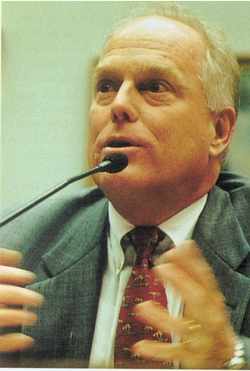Wed, Feb 09, 2005
AIP Program Takes Major Hit
 NATA President James K. Coyne
greeted the arrival of President Bush’s Fiscal Year 2006
budget with concern due to cuts in Federal Aviation Administration
(FAA) spending. The President’s budget contains cuts both in
the FAA's Facilities and Equipment (F&E) account as well as the
popular Airport Improvement Program (AIP).
NATA President James K. Coyne
greeted the arrival of President Bush’s Fiscal Year 2006
budget with concern due to cuts in Federal Aviation Administration
(FAA) spending. The President’s budget contains cuts both in
the FAA's Facilities and Equipment (F&E) account as well as the
popular Airport Improvement Program (AIP).
The Administration requested $3 billion for AIP funding, which is
$500 million below the amount authorized in the most recent FAA
Reauthorization, Vision-100. Like last year, the FAA's F&E
budget also suffers a drastic reduction, with $2.448 billion
requested, approximately $600 million less than authorized in
Vision-100.
"I am concerned that the Administration is neglecting to look at
the big picture when it comes to analyzing our national aviation
system," Coyne said. "Significantly cutting aviation funding at a
time when Americans are returning to the skies in record numbers
can have a far-reaching negative impact on the industry.
Additionally, once again reducing much-needed funds for the FAA to
modernize the air traffic control system only serves to worsen the
problems we face today, with antiquated technology holding back the
potential for significant improvements to the system. I understand
the President has some tough choices to make in this year's budget
proposal, and hopefully the Administration and Congressional
leaders can eventually reach a compromise that includes more
funding for FAA programs."
The budget also proposes to fund the Transportation Security
Administration (TSA) at a level of $5.561 billion, which is an
increase of $156 million from FY 2005. TSA spending is now
approximately 14% of the budget of the Department of Homeland
Security.
 "We are pleased the Administration
is equipping the TSA with more resources with which to conduct its
mission," Coyne (right) stated. "NATA is hopeful the TSA will
continue to invest in programs featuring biometric technology, as
well as the development of the Transportation Worker Identification
Card (TWIC). New programs like these can greatly increase aviation
security while creating efficiencies that can generate savings for
both the government and industry in the long run. NATA will also
seek to ensure that the ‘Twelve-Five' Security Program for
on-demand air charter operators receives the proper staffing and
funding. Attention to the program has greatly improved in recent
budget proposals, but the program continues to fall short of the
funding it needs."
"We are pleased the Administration
is equipping the TSA with more resources with which to conduct its
mission," Coyne (right) stated. "NATA is hopeful the TSA will
continue to invest in programs featuring biometric technology, as
well as the development of the Transportation Worker Identification
Card (TWIC). New programs like these can greatly increase aviation
security while creating efficiencies that can generate savings for
both the government and industry in the long run. NATA will also
seek to ensure that the ‘Twelve-Five' Security Program for
on-demand air charter operators receives the proper staffing and
funding. Attention to the program has greatly improved in recent
budget proposals, but the program continues to fall short of the
funding it needs."
Following the introduction of the President's budget, Coyne hopes
the annual budget and appropriations process can begin moving
quickly on Capitol Hill. "Although this year's budget will present
a number of challenges for both the President and Congress, I
sincerely hope Congressional leaders can quickly adopt a budget
resolution and start the appropriations process," Coyne concluded.
"NATA will continue to work to see that the FAA is given the proper
resources to maintain and expand our national aviation system. We
will also continue to keep a watchful eye on any attempts to
incorporate user fees on the aviation industry as a means to make
up for budget shortfalls as the process continues."
More News
Aero Linx: International Federation of Airworthiness (IFA) We aim to be the most internationally respected independent authority on the subject of Airworthiness. IFA uniquely combi>[...]
Ultrahigh Frequency (UHF) The frequency band between 300 and 3,000 MHz. The bank of radio frequencies used for military air/ground voice communications. In some instances this may >[...]
A Few Questions AND Answers To Help You Get MORE Out of ANN! 1) I forgot my password. How do I find it? 1) Easy... click here and give us your e-mail address--we'll send it to you >[...]
From 2019 (YouTube Edition): Learning To Paint Without Getting Any On Your Hands PPG's Aerospace Coatings Academy is a tool designed to teach everything one needs to know about all>[...]
Also: Sustainable Aircraft Test Put Aside, More Falcon 9 Ops, Wyoming ANG Rescue, Oreo Cookie Into Orbit Joby Aviation has reason to celebrate, recently completing its first full t>[...]
 ANN's Daily Aero-Linx (05.06.25)
ANN's Daily Aero-Linx (05.06.25) ANN's Daily Aero-Term (05.06.25): Ultrahigh Frequency (UHF)
ANN's Daily Aero-Term (05.06.25): Ultrahigh Frequency (UHF) ANN FAQ: Q&A 101
ANN FAQ: Q&A 101 Classic Aero-TV: Virtual Reality Painting--PPG Leverages Technology for Training
Classic Aero-TV: Virtual Reality Painting--PPG Leverages Technology for Training Airborne 05.02.25: Joby Crewed Milestone, Diamond Club, Canadian Pilot Insurance
Airborne 05.02.25: Joby Crewed Milestone, Diamond Club, Canadian Pilot Insurance




